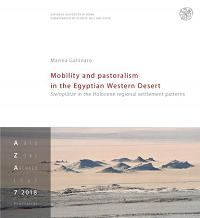 Nouvelles parutions hors SPF
Nouvelles parutions hors SPF 

 |
[Néolithique / Afrique] Marina Gallinaro (2018) - Mobility and pastoralism in the Egyptian Western Desert. Steinplätze in the Holocene regional settlement patterns, Firenze, All'Insegna del Giglio, 180 p. EAN 9788878148611, 25,00 €. This volume presents the results of a long study begun in 2004 within the framework of the Archaeological Mission in the Farafra Oasis of Egypt directed by Barbara Barich and Giulio Lucarini, of the Sapienza University of Rome (now under the auspices of ISMEO). The book focuses on the features known as “Steinplatz-type hearths” and their role in the settlement patterns of the human groups living in the Egyptian Western Desert during the middle and late Holocene. Steinplätze are concentrations of burned and fire-cracked stones that vary in shape and size, and have often been slightly elevated above the present ground level by post-depositional erosion processes. Occurring both as isolated features and in clusters, they are often the only visible structures – or even traces – of ancient settlements. The study of these features is closely interconnected with the mobility strategies of the communities that inhabited this desert region during a period of higher average rainfall than at present but also characterised by significant climate fluctuations, with humid periods interrupted by dry spells and eventually ending in an overall trend towards greater desertification. The use of the Steinplatz-type hearths was most widespread in the second half of the sixth millennium BC, when mobile occupation strategies replaced a more sedentary model. An analysis of the Farafra Oasis Steinplätze is coupled with a general reassessment of the subsistence and mobility models hitherto proposed for the Eastern Sahara, suggesting an integrated occupation system for Farafra itself. The economy of the forager-herders of the middle Holocene, during the climate optimum (6900-5550 cal BC), seems to have relied significantly on herding small livestock, but also on hunting, and likely concentrated on the gathering of wild cereals such as sorghum. During the climate optimum, forms of seasonal stabilisation of the settlement strategy seem to emerge, with the alternating occupation of two different winter and summer villages consisting of clusters of stone-slab huts; short-term task-specific camps, using Steinplätze, logistically completed the system. After this phase, only short-term camps with Steinplätze were occupied. These were probably directly dependent on the wettest areas at the centre of the oases and made use of a tethered exploitation strategy, with brief movements from the central oasis (“daisy-chain” movements). The use strategies of the Steinplatz-type hearths within the mobile settlement system are outlined adopting a clear and immediately assessable model. “Yet although they are among the most distinctive of the Sahara’s archaeological features, Steinplätze have received little systematic attention in recent decades. Marina Gallinaro’s work thus marks a new phase in their study, one that draws them back into discussions of how early livestock-keeping populations in Northeast Africa used the resources and landscapes to the west of the Nile along a trajectory of increasing aridification that eventually culminated in the desert we see today (…) Lucidly written, Gallinaro’s volume will, I believe, help inspire individuals to take up the research agenda she sets out. At a time when so much of the Sahara is off-limits to archaeological fieldwork, it is deeply gratifying to see here yet more evidence of the thoroughness and high quality that have characterized the work of Italian archaeologists in this region of Africa over many decades. The continuing publication of their research, Marina Gallinaro’s included, in the Arid Zone Archaeology monograph series will surely help sustain widespread interest in Saharan archaeology until it becomes possible to excavate and survey again free of current geopolitical restrictions. May that day come soon!” Prof. Peter Mitchell, University of Oxford, UK. |


